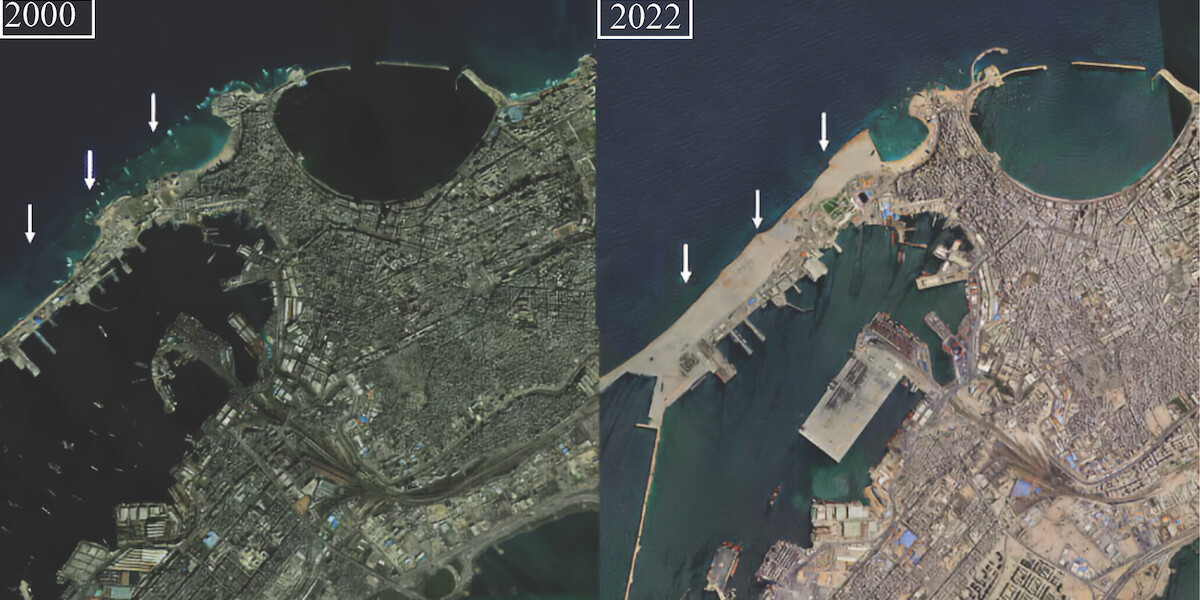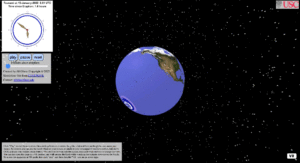
Satellite imagery compares image of Alexandria’s Port in 2000 to 2022.
Catastrophic flooding, the hottest day on record, landslides and deadliest wildfires to date. Arid areas are sending us warning signs, says Essam Heggy, a water scientist at the USC Viterbi School of Engineering. Heggy studies deserts’ responses to climatic changes. He recently published series of new papers reporting alarming changes in ports cities in North Africa and the Middle East.
“We are losing the battle against extreme hydroclimate events,” says Heggy. The new papers highlight what he indicates are critical developments in Alexandria, Egypt; Manama, Bahrain; and Tangier, Morocco. Heggy says while these locales are thousands of miles apart, they are all showing alarming climatic vulnerabilities combined with a decreased public awareness of these growing threats.
Heggy cautions that the problems coastal cities face in arid areas are happening much sooner than expected. These ports export crucial energy resources and goods globally and are the gateway for vital food provisions. Heggy warns that their rapid degradation can have regional and global consequences on consumers worldwide.

Alexandria, Egypt:
Heggy and colleagues Sara Fouad, a Humboldt Research Fellow hosted by TUM Landscape Architecture (who grew up in Alexandria) and Udo Weilacher, Chair of Landscape Architecture and Transformation at TUM, explain in a paper published in Cities how Alexandria, Egypt, its renowned UNESCO sites and six million inhabitants, became increasingly vulnerable to coastal flooding and erosion. The researchers credit a series of development projects that took place over the last decade where priority has been given to expanding highways and commercial areas by filling up important waterways that were crucial for regulating hydroclimatic extremes.
Fouad, the paper’s first author, says her hometown was able to “survive thousands of years resisting earthquakes, sea-level rise, tsunamis, and storm surges, but mismanagement of the city’s waterways, and urban landscape development over the last ten years, has brought ‘the city to its knees.’” She states the city has become “one of the most vulnerable places on Earth for coastal flooding and sea-level rise.”
The researchers used satellite images, mapping records, in-situ validations on the ground, and public questionnaires to assess the rapid increase in climate vulnerabilities. The published paper explains how filling in waterways reduces coastal cities’ ability to mitigate climate extremes. Traditionally, the researchers explain, canals would cool the city climate and in the process of flowing out to sea, deposit sediment on the coast that would create a natural bulwark against erosion and storm surges. Without these ancient waterways depositing new sediment on the coastlines, Alexandria’s coasts are increasingly depleted of these natural barriers against sea-level rise and increasing storm surges. These developments in port cities like Alexandria accelerate coastal degradation and increases the risks associated with climate extremes.
Co-author Udo Weilacher, believes that filling waterways with landfill has another far-reaching impact: decreasing the public’s sensitivity to their situated proximity to the coast and hydroclimate vulnerabilities. “When you take out the waterways, people will not feel rooted in their landscape anymore, and they lose their cultural connection to both the Nile and the Mediterranean Sea,” says Weilacher.
The researchers found that the younger generation’s perception of climatic risks was particularly altered by the city’s multiple transformations, changing the sea waterfront and filling waterways and that this hinders efforts to mitigate rising coastal hazards, which explains the increase in mortality observed in these events over the last decade.
“Alexandria’s experience with climate extremes offers valuable insights for coastal cities worldwide. The complex interplay between climate and environmental changes and their public perception in dense urban populations requires a multifaceted, integrated approach to adaptation that is not yet there in several developing nations,” says Heggy.

Manama, Bahrain:
A second paper co-authored by Heggy looks at the port city of Manama in Bahrain–sixteen hundred miles to the East of Alexandria. The city, he says, is one of the oldest and most significant ports in the Gulf and is witnessing a large-scale subsidence. The paper, published in IEEE-STARS, suggests that this sinking land is affiliated with the increase in oil field production, local aquifer depletion, and subsurface dissolution of anhydrite and chalky-limestones.
Tangier, Morocco:
A third paper co-authored by Heggy in Scientific Reports documents how 2800 miles to the west of Alexandria, the port city of Tangier in Morocco, and one of the largest African export ports, is now facing a similar predicament: increased flooding and soil erosion. Similar to Alexandria, these risks, the authors indicate are coming from growing urban sprawl aggravated by increased climatic extremes observed over the last decade.
These research paper can be found as follows:
1. “Waterways transformation in the vulnerable port city of Alexandria”
2. “Probing Shallow Aquifers in Hyper-Arid Dune Fields Using VHF Sounding Radar”
3. “Soil erosion and hydroclimatic hazards in major African port cities: the case study of Tangier “
Published on September 18th, 2023
Last updated on September 19th, 2023











